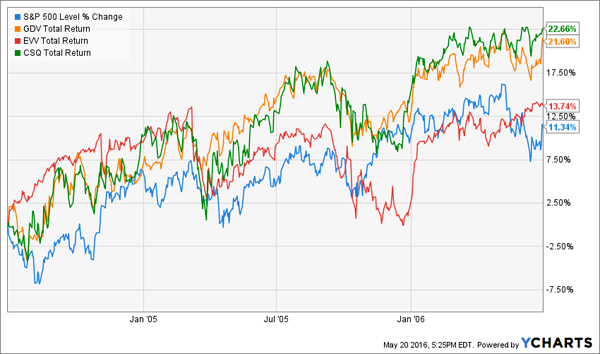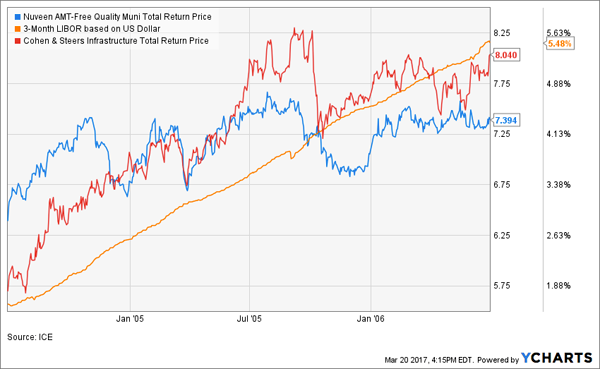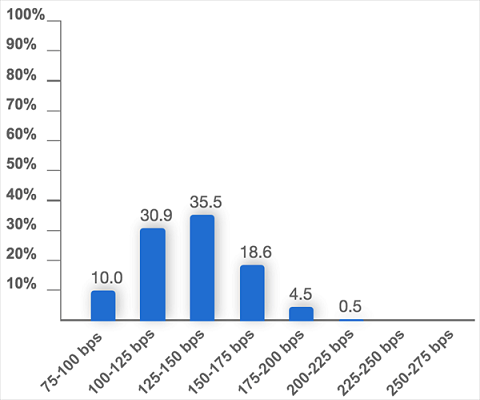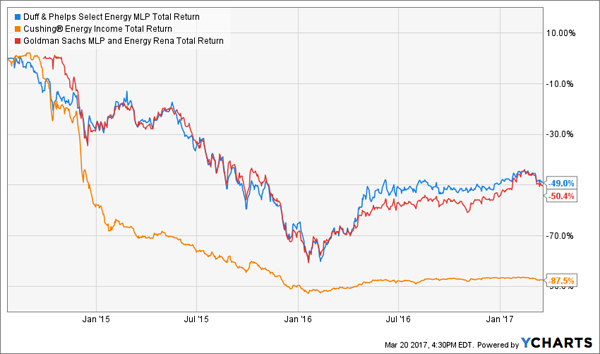Yellen Just Slapped A “Buy” Rating On These 8% Yields
 As recently as last week, many high quality closed-end funds (CEFs) were being neglected thanks to the headline worry that higher rates would hurt them.
As recently as last week, many high quality closed-end funds (CEFs) were being neglected thanks to the headline worry that higher rates would hurt them.
That nonsense stopped abruptly when Fed chair Janet Yellen basically slapped a “Buy” rating on the entire sector! Her dovish outlook was taken as a cue that CEF investors could breathe easy and, once again, collect their 8% yields in peace.
This cue was unnecessary. For starters, anyone who mistook Yellen’s Fed as hawkish was, well, mistaken. And has been for years.
Also, higher rates don’t really hurt CEFs.
The theory scares people because it sounds true. Closed-ends have the benefit of borrowing money at Libor to lever up their returns. Libor is tied closely to the Fed funds rate. So, the thinking goes, higher Fed rates will end the “cheap money” party that benefits CEFs.
Unfortunately this lazy conclusion is just as wrong as the myth that higher rates hurt REITs. Let’s look to history to see why.
In June 2004, Fed chair Alan Greenspan began boosting rates from then-historic lows. Over a two-year period, he increased the federal funds rate from 1% to 5.25%. A dizzying pace by today’s standards.
How’d CEFs perform? These three prominent funds all outperformed the S&P 500 during Greenspan’s aforementioned run!
Higher Rates No Problem for Top CEFs 2004-06

And here are two more blue chip CEFs that moved up along with Libor last hike cycle:
Muni and Infrastructure CEFs Did Well, Too

Let’s put things in perspective. Back then, Greenspan started at 1%. Today, after 15 months of leisurely rate boosts and banter, we’re just now at 1%.
Yellen promised two more rate increases this year. The “smart money” believes her – mostly – but is fading the downside a bit. The Fed Funds futures markets are pricing in one or two more hikes as the most likely outcomes:
Traders Bet on One or Two Hikes by Jan 2018

The Fed rate isn’t projected to hit 3% until the end of 2019. That’s nearly three years of 8%+ dividends we can collect without any rate worries.
Now can we buy any fund and beat the market? Of course not. Ignoring interest rates is one rule for successful income investing in CEFs. Here are three more that will help you generate 8%+ dividends (with double-digit upside to boot).
CEF Rule #1: Demand a Discount
One aspect of the CEF structure lends itself perfectly to contrary-minded investing – fixed pools of shares.
Mutual funds issue more shares whenever they want. But closed-ends have a fixed share count, with their funds trading like stocks. As a result, from time-to-time a fund will fall out-of-favor and find its shares trading at a discount to its NAV.
This is basically “free money” because these underlying assets are constantly marked to market. If a fund trades at a 10% discount, management could theoretically liquidate the fund and cash out everyone at $1.10 on the dollar immediately. Or it can buy back its own shares to close the discount window (and boost the share price).
CEF Rule #2: Avoid New Funds in Hot Sectors
In 2014 – just as energy and MLP stock prices were topping – MLP-focused closed-end funds were the hottest new thing. What a disaster:
2014’s Hottest Funds: MLP Time Bombs

As with stocks, always be contrarian with your CEF purchases. One sign of overheating is the opposite of the discount – the premium. Never buy any fund trading for more than the sum of its parts!
CEF Rule #3: When Possible, Buy Along Insiders
It’s rare to see any fixed income manager put his or her own money on the line at all, unfortunately. According to Barron’s, out of 558 closed-end funds, nearly half (269) have no insider ownership whatsoever. And only 70 have insider ownership above $500,000.
Why would we want to own any of them, if the managers don’t?
PIMCO’s CEO Loves This CEF
Closed-end funds are a cornerstone of my 8% “no withdrawal” retirement strategy, which lets retirees rely entirely on dividend income and leave their principal 100% intact.
Well that’s not exactly right. Their principal is more than 100% intact thanks to price gains like these! Which means principal is actually 110% intact after year 1, and so on.
To do this, I seek out closed-end funds that:
- Pay 8% or better…
- Trade at meaningful discounts to their NAV…
- Know how to make their shareholders money…
- And have big insider ownership and buying.
If you’re an investor who strives to live off dividends alone, while slowly but safely increasing the value of your nest egg, these are the ideal holdings for you. Click here and I’ll explain more about my no withdrawal approach – plus I’ll share the names, tickers and buy prices of my three favorite closed-end funds for 8.2%, 9.9% and 10.1% yields.
Category: Closed-End Funds (CEFs)




